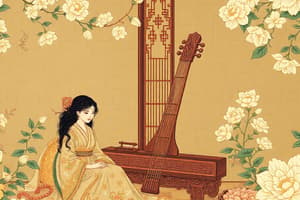Podcast
Questions and Answers
Yatsuhashi Kengyo's enduring legacy is primarily attributed to which contribution to Japanese music?
Yatsuhashi Kengyo's enduring legacy is primarily attributed to which contribution to Japanese music?
- Popularizing the shakuhachi flute and composing its foundational repertoire.
- Elevating the koto from courtly ensemble instrument to a widely accessible solo instrument. (correct)
- Introducing Western musical harmony into traditional Japanese court music.
- Inventing the koto and establishing its fundamental playing techniques.
Prior to Yatsuhashi Kengyo's influence, in what musical context was the koto primarily utilized?
Prior to Yatsuhashi Kengyo's influence, in what musical context was the koto primarily utilized?
- Exclusively in religious ceremonies within Buddhist temples.
- As part of ensembles within royal courts and religious settings. (correct)
- As a central instrument in folk music traditions of rural Japan.
- As a solo instrument in public concerts for the common people.
Who is credited with instructing Yatsuhashi Kengyo in the art of playing the koto?
Who is credited with instructing Yatsuhashi Kengyo in the art of playing the koto?
- Torii Suneemon, a master of Noh theatre music.
- Kenjun, a Buddhist priest. (correct)
- Emperor Go-Mizunoo, a known patron of the arts.
- Lady Murasaki Shikibu, a renowned court musician.
Which of the following best describes the traditional hand placement and plucking technique for playing the koto as described?
Which of the following best describes the traditional hand placement and plucking technique for playing the koto as described?
What is the structural organization of Yatsuhashi Kengyo's renowned composition, Rokudan no Shirabe?
What is the structural organization of Yatsuhashi Kengyo's renowned composition, Rokudan no Shirabe?
Rokudan no Shirabe is recognized for its pedagogical value in koto instruction because it:
Rokudan no Shirabe is recognized for its pedagogical value in koto instruction because it:
Beyond its original koto form, Rokudan no Shirabe's melody has experienced adaptations primarily through:
Beyond its original koto form, Rokudan no Shirabe's melody has experienced adaptations primarily through:
What is the direct connection between Yatsuhashi Kengyo and the confectionary named 'Yatsuhashi'?
What is the direct connection between Yatsuhashi Kengyo and the confectionary named 'Yatsuhashi'?
Flashcards
Yatsubashi Kengyo
Yatsubashi Kengyo
A Japanese musician known as the 'father of modern koto'.
Koto
Koto
A traditional Japanese string instrument played using picks.
Rokudan no Shirabe
Rokudan no Shirabe
Yatsuhashi's famous koto composition featuring six variations.
Koto playing technique
Koto playing technique
Signup and view all the flashcards
Dan in music
Dan in music
Signup and view all the flashcards
Yatsubashi Sweets
Yatsubashi Sweets
Signup and view all the flashcards
Koto's popularity
Koto's popularity
Signup and view all the flashcards
Yatsuhashi's influence
Yatsuhashi's influence
Signup and view all the flashcards
Study Notes
Yatsubashi Kengyo
- Yatsubashi Kengyo was a highly talented Japanese musician, often called the "father of modern koto."
- He was born in 1614 and died in 1685.
- Kengyo was taught to play koto by a Buddhist priest.
- He developed new koto techniques and composed many solo pieces.
- His work significantly increased the koto's popularity and its accessibility to the public.
Rokudan no Shirabe
- Rokudan no Shirabe is Yatsusbasbi’s most famous piece.
- This piece is a koto study in six steps.
- Rokudan no Shirabe is a classical koto piece composed in the 17th century.
- Each step has 52 beats and a total of six different variations.
Studying That Suits You
Use AI to generate personalized quizzes and flashcards to suit your learning preferences.


